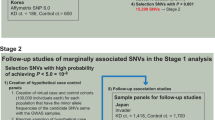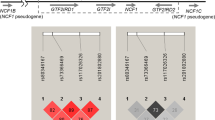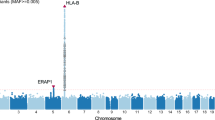Abstract
Recently, a functional polymorphism in the NFKB1 gene promoter (−94ins/del ATTG) has been identified and associated with chronic inflammatory diseases. The aim of this study was to analyze the association of NFKB1 polymorphism with susceptibility to and phenotype of Graves' disease (GD). The initial case–control association study, performed in a Polish–Warsaw cohort (388 GD patients and 688 controls), was followed by the two replication studies performed in Polish–Gliwice and Japanese–Kurume cohorts (198 GD patients and 194 controls, and 424 GD patients and 222 controls, respectively). The frequency of the −94del ATTG (D) allele was increased in GD compared to controls in Warsaw cohort. This finding was replicated in Gliwice cohort. Combining both Polish–Caucasian cohorts showed that the NFKB1 polymorphism was significantly associated with susceptibility to GD with a codominant mode of inheritance (P=0.00005; OR=1.37 (1.18–1.60)). No association with GD was found in Japanese cohort. However, subgroup analysis in Japanese GD patients revealed a correlation between the NFKB1genotype and the development of ophthalmopathy (P=0.009; OR=1.49 (1.10–2.01)), and the age of disease onset (P=0.009; OR=1.45 (1.09–1.91)). Our results suggest that NFKB1 −94ins/del ATTG polymorphism may be associated with susceptibility to and/or phenotype of GD.
This is a preview of subscription content, access via your institution
Access options
Subscribe to this journal
Receive 6 digital issues and online access to articles
$119.00 per year
only $19.83 per issue
Buy this article
- Purchase on Springer Link
- Instant access to full article PDF
Prices may be subject to local taxes which are calculated during checkout
Similar content being viewed by others
Accession codes
References
Tak PP, Firestein GS . NF-kappaB: a key role in inflammatory diseases. J Clin Invest 2001; 107: 7–11.
Kumar A, Takada Y, Boriek AM, Aggarwal BB . Nuclear factor-kappaB: its role in health and disease. J Mol Med 2004; 82: 434–448.
Courtois G, Gilmore TD . Mutations in the NF-kappaB signaling pathway: implications for human disease. Oncogene 2006; 25: 6831–6843.
Guo D, Li M, Zhang Y, Yang P, Eckenrode S, Hopkins D et al. A functional variant of SUMO4, a new I kappa B alpha modifier, is associated with type 1 diabetes. Nat Genet 2004; 36: 837–841.
Tsurumaru M, Kawasaki E, Ida H, Migita K, Moriuchi A, Fukushima K et al. Evidence for the role of small ubiquitin-like modifier 4 as a general autoimmunity locus in the Japanese population. J Clin Endocrinol Metab 2006; 91: 3138–3143.
Noso S, Ikegami H, Fujisawa T, Kawabata Y, Asano K, Hiromine Y et al. Association of SUMO4, as a candidate gene for IDDM5, with susceptibility to type 1 diabetes in Asian populations. Ann N Y Acad Sci 2006; 1079: 41–46.
Ikegami H, Fujisawa T, Kawabata Y, Noso S, Ogihara T . Genetics of type 1 diabetes: similarities and differences between Asian and Caucasian populations. Ann N Y Acad Sci 2006; 1079: 51–59.
Jennings CE, Owen CJ, Wilson V, Pearce SH . No association of the codon 55 methionine to valine polymorphism in the SUMO4 gene with Graves' disease. Clin Endocrinol (Oxf) 2005; 62: 362–365.
Simmonds MJ, Heward JM, Carr-Smith J, Foxall H, Franklyn JA, Gough SC . Contribution of single nucleotide polymorphisms within FCRL3 and MAP3K7IP2 to the pathogenesis of Graves' disease. J Clin Endocrinol Metab 2006; 91: 1056–1061.
Smyth DJ, Howson JM, Lowe CE, Walker NM, Lam AC, Nutland S et al. Assessing the validity of the association between the SUMO4 M55V variant and risk of type 1 diabetes. Nat Genet 2005; 37: 110–111.
Karban AS, Okazaki T, Panhuysen CI, Gallegos T, Potter JJ, Bailey-Wilson JE et al. Functional annotation of a novel NFKB1 promoter polymorphism that increases risk for ulcerative colitis. Hum Mol Genet 2004; 13: 35–45.
Borm ME, van Bodegraven AA, Mulder CJ, Kraal G, Bouma G . A NFKB1 promoter polymorphism is involved in susceptibility to ulcerative colitis. Int J Immunogenet 2005; 32: 401–405.
Glas J, Torok HP, Tonenchi L, Muller-Myhsok B, Mussack T, Wetzke M et al. Role of the NFKB1 -94ins/del ATTG promoter polymorphism in IBD and potential interactions with polymorphisms in the CARD15/NOD2, IKBL, and IL-1RN genes. Inflamm Bowel Dis 2006; 12: 606–611.
Mirza MM, Fisher SA, Onnie C, Lewis CM, Mathew CG, Sanderson J et al. No association of the NFKB1 promoter polymorphism with ulcerative colitis in a British case control cohort. Gut 2005; 54: 1205–1206.
Oliver J, Gomez-Garcia M, Paco L, Lopez-Nevot MA, Pinero A, Correro F et al. A functional polymorphism of the NFKB1 promoter is not associated with ulcerative colitis in a Spanish population. Inflamm Bowel Dis 2005; 11: 576–579.
Orozco G, Sanchez E, Collado MD, Lopez-Nevot MA, Paco L, Garcia A et al. Analysis of the functional NFKB1 promoter polymorphism in rheumatoid arthritis and systemic lupus erythematosus. Tissue Antigens 2005; 65: 183–186.
Rueda B, Nunez C, Lopez-Nevot MA, Paz Ruiz M, Urcelay E, De la Concha EG et al. Functional polymorphism of the NFKB1 gene promoter is not relevant in predisposition to celiac disease. Scand J Gastroenterol 2006; 41: 420–423.
Kosoy R, Concannon P . Functional variants in SUMO4, TAB2, and NFkappaB and the risk of type 1 diabetes. Genes Immun 2005; 6: 231–235.
Martinez A, Sanchez E, Valdivia A, Orozco G, Lopez-Nevot MA, Pascual-Salcedo D et al. Epistatic interaction between FCRL3 and NFkappaB1 genes. Ann Rheum Dis 2006; 65: 1188–1191.
Kochi Y, Yamada R, Suzuki A, Harley JB, Shirasawa S, Sawada T et al. A functional variant in FCRL3, encoding Fc receptor-like 3, is associated with rheumatoid arthritis and several autoimmunities. Nat Genet 2005; 37: 478–485.
Hegazy DM, O'Reilly DA, Yang BM, Hodgkinson AD, Millward BA, Demaine AG . NFkappaB polymorphisms and susceptibility to type 1 diabetes. Genes Immun 2001; 2: 304–308.
Gylvin T, Bergholdt R, Nerup J, Pociot F . Characterization of a nuclear-factor-kappa B (NFkappaB) genetic marker in type 1 diabetes (T1DM) families. Genes Immun 2002; 3: 430–432.
Smyth DJ, Howson JM, Payne F, Maier LM, Bailey R, Holland K et al. Analysis of polymorphisms in 16 genes in type 1 diabetes that have been associated with other immune-mediated diseases. BMC Med Genet 2006; 7: 20.
Hiromatsu Y, Yang D, Bednarczuk T, Miyake I, Nonaka K, Inoue Y . Cytokine profiles in eye muscle tissue and orbital fat tissue from patients with thyroid-associated ophthalmopathy. J Clin Endocrinol Metab 2000; 85: 1194–1199.
Ajjan RA, Weetman AP . New understanding of the role of cytokines in the pathogenesis of Graves'ophthalmopathy. J Endocrinol Invest 2004; 27: 237–245.
Cao HJ, Smith TJ . Leukoregulin upregulation of prostaglandin endoperoxide H synthase-2 expression in human orbital fibroblasts. Am J Physiol 1999; 277: C1075–C1085.
De Bosscher K, Vanden Berghe W, Haegeman G . The interplay between the glucocorticoid receptor and nuclear factor-kappaB or activator protein-1: molecular mechanisms for gene repression. Endocr Rev 2003; 24: 488–522.
Garrity JA, Bahn RS . Pathogenesis of Graves' ophthalmopathy: implications for prediction, prevention,and treatment. Am J Ophthalmol 2006; 142: 147–153.
Manji N, Carr-Smith JD, Boelaert K, Allahabadia A, Armitage M, Chatterjee VK et al. Influences of age, gender, smoking, and family history on autoimmune thyroid disease phenotype. J Clin Endocrinol Metab 2006; 91: 4873–4880.
Bednarczuk T, Hiromatsu Y, Fukutani T, Jazdzewski K, Miskiewicz P, Osikowska M et al. Association of cytotoxic T-lymphocyte-associated antigen-4 (CTLA-4) gene polymorphism and non-genetic factors with Graves' ophthalmopathy in European and Japanese populations. Eur J Endocrinol 2003; 48: 13–18.
Johnson GC, Esposito L, Barratt BJ, Smith AN, Heward J, Di Genova G et al. Haplotype tagging for the identification of common disease genes. Nat Genet 2001; 29: 233–237.
Kavvoura FK, Akamizu T, Awata T, Ban Y, Chistiakov DA, Frydecka I et al. CTLA-4 gene polymorphisms and autoimmune thyroid disease: a meta analysis. J Clin Endocrinol Metab (in press).
Kula D, Bednarczuk T, Jurecka-Lubieniecka B, Polanska J, Hasse-Lazar K, Jarzab M et al. Interaction of HLA-DRB1 alleles with CTLA-4 in the predisposition to Graves' disease: The impact of DRB1*07. Thyroid 2006; 16: 447–453.
Perneger TV . What's wrong with Bonferroni adjustment? BMJ 1998; 316: 1236–1238.
Hosmer D, Lemeshow S . Applied Logistic Regression, 2nd edn. Wiley Interscience: New York, 2000, pp 70–79.
Acknowledgements
This work was supported by the State Committee for Scientific Research Grants No. 2 PO5B 120 29, 3 T11F 010 29 and the Medical University of Warsaw Grant 1WY/N/2007.
Author information
Authors and Affiliations
Corresponding author
Additional information
Disclosure summary
None.
Rights and permissions
About this article
Cite this article
Kurylowicz, A., Hiromatsu, Y., Jurecka-Lubieniecka, B. et al. Association of NFKB1 −94ins/del ATTG promoter polymorphism with susceptibility to and phenotype of Graves' disease. Genes Immun 8, 532–538 (2007). https://doi.org/10.1038/sj.gene.6364418
Received:
Accepted:
Published:
Issue Date:
DOI: https://doi.org/10.1038/sj.gene.6364418
Keywords
This article is cited by
-
Association of NFKB1 gene rs28362491 mutation with the occurrence of major adverse cardiovascular events
BMC Cardiovascular Disorders (2022)
-
Genetic associations in type I interferon related pathways with autoimmunity
Arthritis Research & Therapy (2010)
-
Identification of NF-κB1 and NF-κBIΑ Polymorphisms Using PCR–RFLP Assay in a Turkish Population
Biochemical Genetics (2010)



